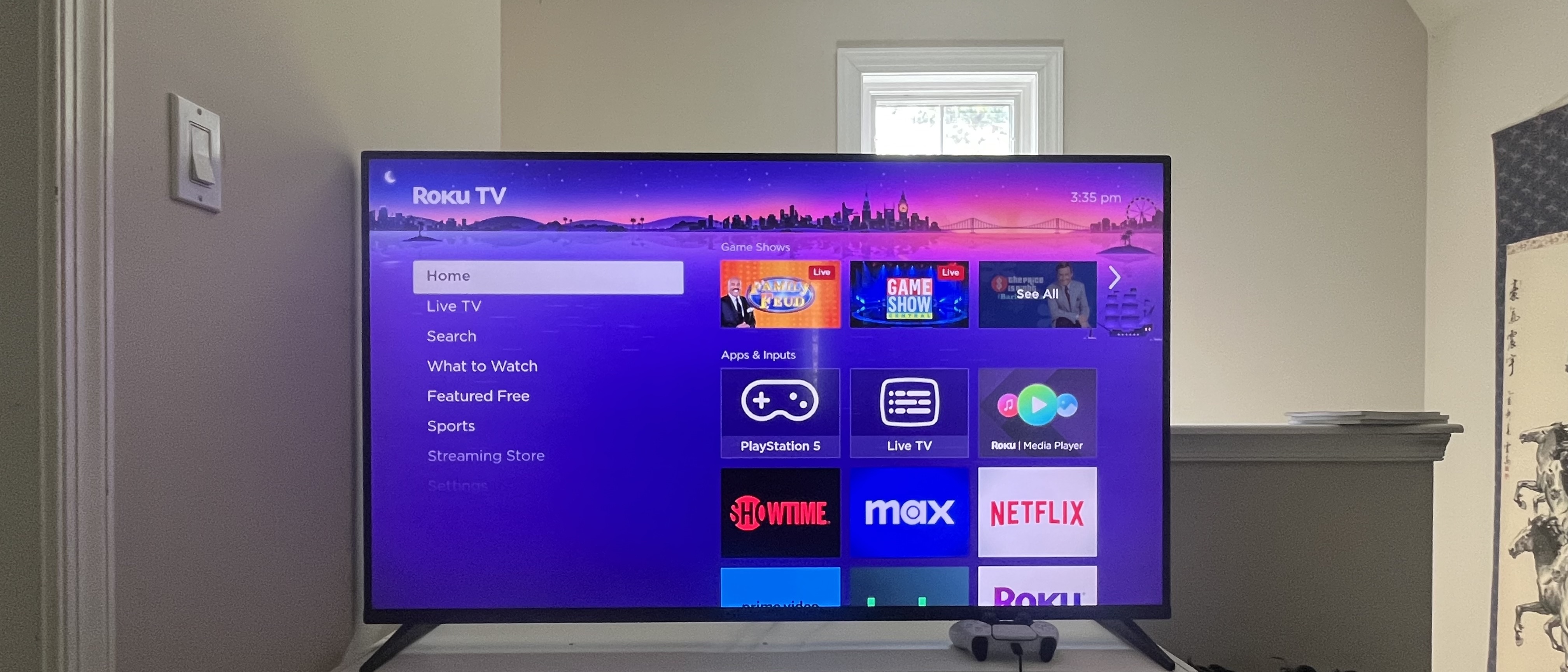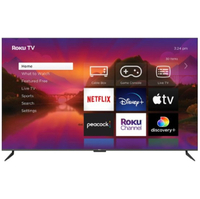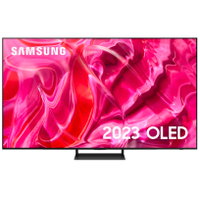TechRadar Verdict
The Roku Pro Series is relatively affordable for a flagship TV and comes with useful features and an interesting design that makes it fairly unique. Picture quality overall is very good, though it’s not as bright as other premium mini-LED TVs.
Pros
- +
Shadowbox design ideal for wall-mounting
- +
The price is right
- +
Fantastic new remote
Cons
- -
Average brightness
- -
Only two HDMI 2.1 ports
Why you can trust TechRadar
Roku Pro Series: Two-minute review
The Roku Pro Series is the company’s new flagship TV offering. Roku has been a major player in our living rooms for a long time, starting out with streaming boxes and sticks. Those evolved to soundbars and wireless speakers, followed by last year’s initial foray into TVs with the Roku Select and Roku Plus Series. Building on those models, the Roku Pro Series takes things up a level with some interesting and unique design choices and useful features.
Considering the Roku Pro Series’ relatively affordable prices, starting at $899.99 for the 55-inch model, it’s certainly in the running for best TVs for those who are a little more price-conscious.
While the Pro Series is Roku’s premium offering, there are innovations on hand that make it worthy of consideration over Roku’s budget Select and mid-tier Plus TVs. For one, it offers better picture quality than those models thanks to a mini-LED backlight with local dimming. It also has 4K 120Hz support for gaming and side-firing speakers that provide superior sound quality.
This TV has some tricks up its sleeve feature-wise as well, such as the ability to switch picture modes not just between different forms of content but different scenes. A planned software update will also bring an artmode feature that turns the TV into a showcase for artwork when not in use, similar to Samsung’s The Frame TVs. Of course, the interface overall is a joy to use, as I’ll discuss later.
The TV’s design may be where I’m most impressed. There are TVs with similarly impressive picture quality for under $1,000 (the Hisense U8K Series TV comes to mind). However, no other TV that I know of is made to be intentionally thicker so that it mounts flush against the wall instead of precariously jutting out like most TVs, and there’s cable management to accommodate that installation. The upgraded second edition of the Roku Voice Remote Pro is pretty special as well, and not just because it has backlighting.
Everything about the Roku Pro Series TV follows an ethos that seems to permeate Roku products, and that is convenience. If you care about the absolute best picture quality, you might look elsewhere, though I think the Pro Series’ picture is more than good enough for most people. But setting this TV up, using it and its various features, and even dealing with how it integrates into your space, has been thought out in a way that most products this side of Apple aren’t.
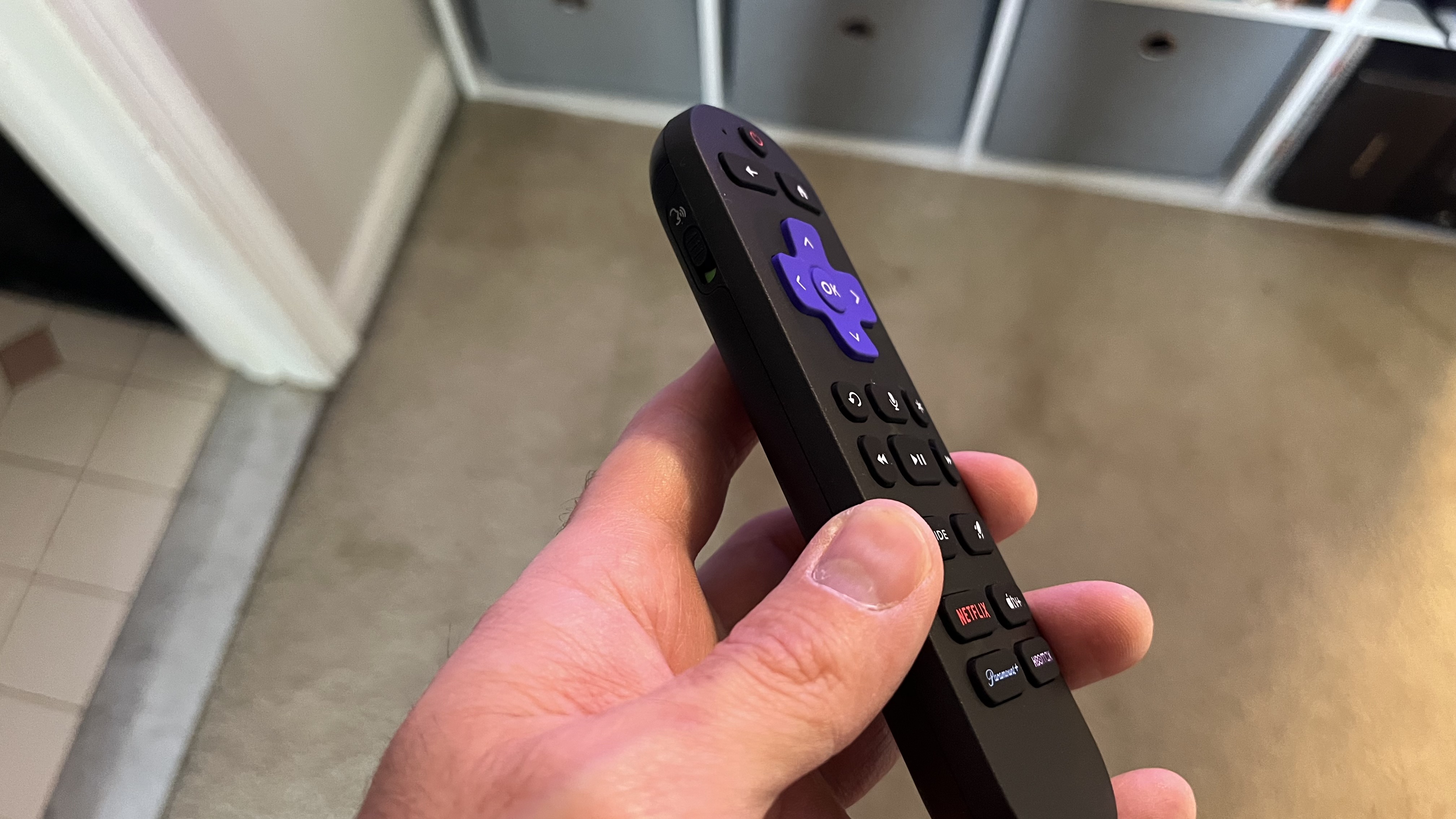
Roku Pro Series review: Price and release date
- Release date: April 2024
- 55-inch: $899.99
- 65-inch: $1,199.99
- 75-inch: $1,699.99
The Roku Pro Series might be the company’s premium offering, but the price tag is in mid-range TV territory. The smallest of the Pro Series – it comes in three sizes (55-, 65-, and 75-inch) – retails for a surprisingly affordable $899.99.
If 55 inches is too small, stepping up to the 65-inch model is an extra $200, coming in at $1,199.99, while the 75-inch goes for $1,699.99. Despite the difference in price between models, they’re all the same other than size.
Roku Pro Series review: Specs
Screen type: | QLED with mini-LED |
Refresh rate: | 120Hz |
HDR support: | Dolby Vision IQ, HDR10+, HDR10, HLG |
Audio support: | Dolby Atmos |
Smart TV: | Roku |
HDMI ports: | 4 (2x HDMI 2.1) |
Built-in tuner: | ATSC 1.0 |
Roku Pro Series review: Benchmark results
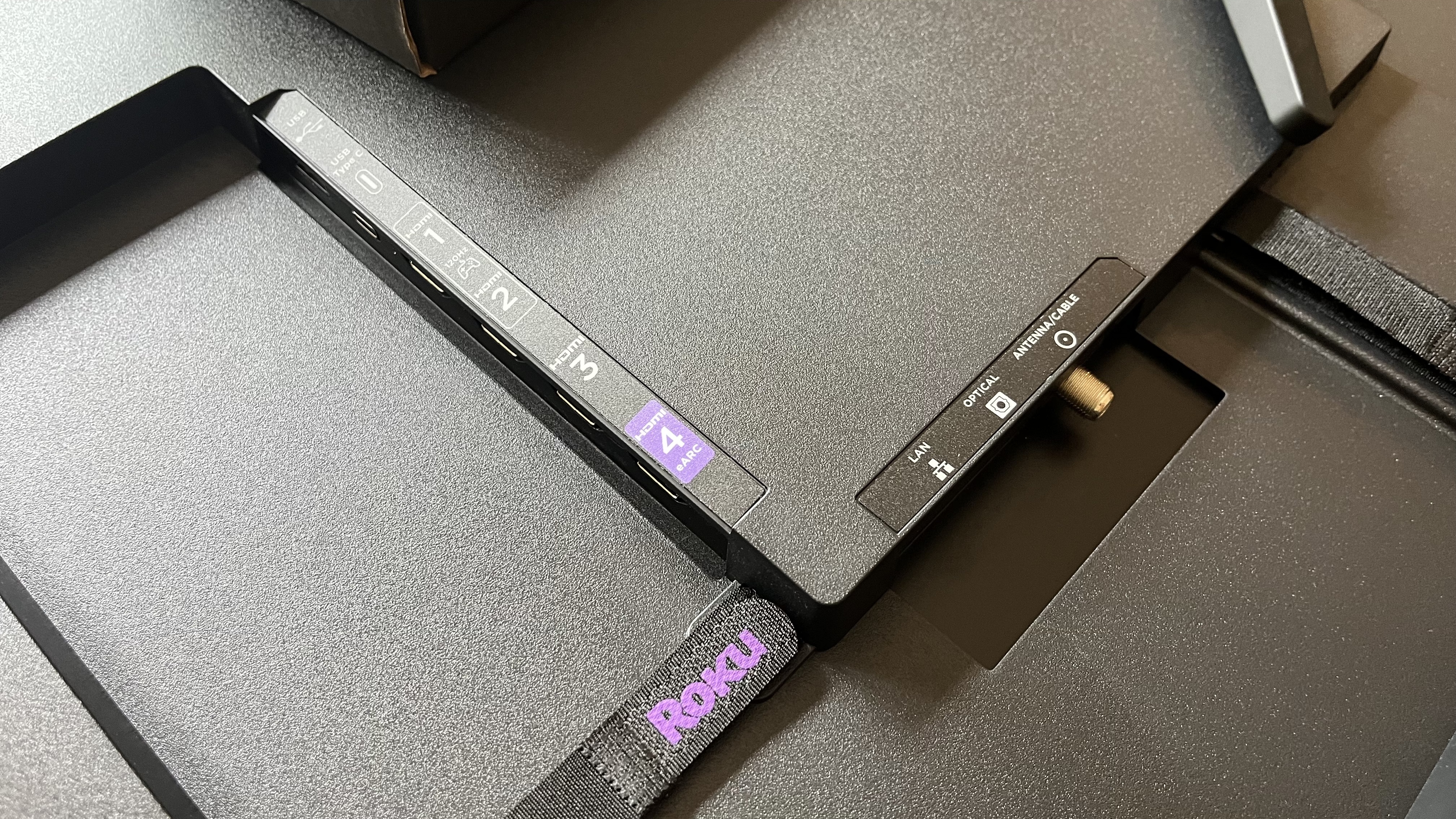
Roku Pro Series review: Features
- Smart Home Ready
- Auto-switching picture settings
- Two HDMI 2.1 ports
Roku’s Pro Series TV is feature-filled. You can pair it with wireless headphones or with Roku’s lineup of wireless speakers. You can connect it with Google Home, Alexa, Apple Home, and Roku Smart Home. There’s even a mode that will be rolled out in a future software update to turn the TV into a piece of artwork when not in use.
Even without the smart home stuff, there’s plenty to get excited about. The TV comes with Dolby Vision IQ, which adjusts the picture settings based on the ambient light level in your room when watching. And there’s what Roku calls Smart Picture Max, a feature that automatically changes the picture settings based on the type of content you’re watching and can even make changes on a scene-by-scene basis. It’s also worth mentioning that the speakers are Dolby Atmos-certified.
If you plan on plugging in external devices, Pro series TVs have four HDMI ports including two HDMI 2.1 ports with 4K 120Hz support – something next-gen console gamers will appreciate.. There’s also a USB-A, useful in particular for charging the remote, and a USB-C port.
- Features Score: 4/5
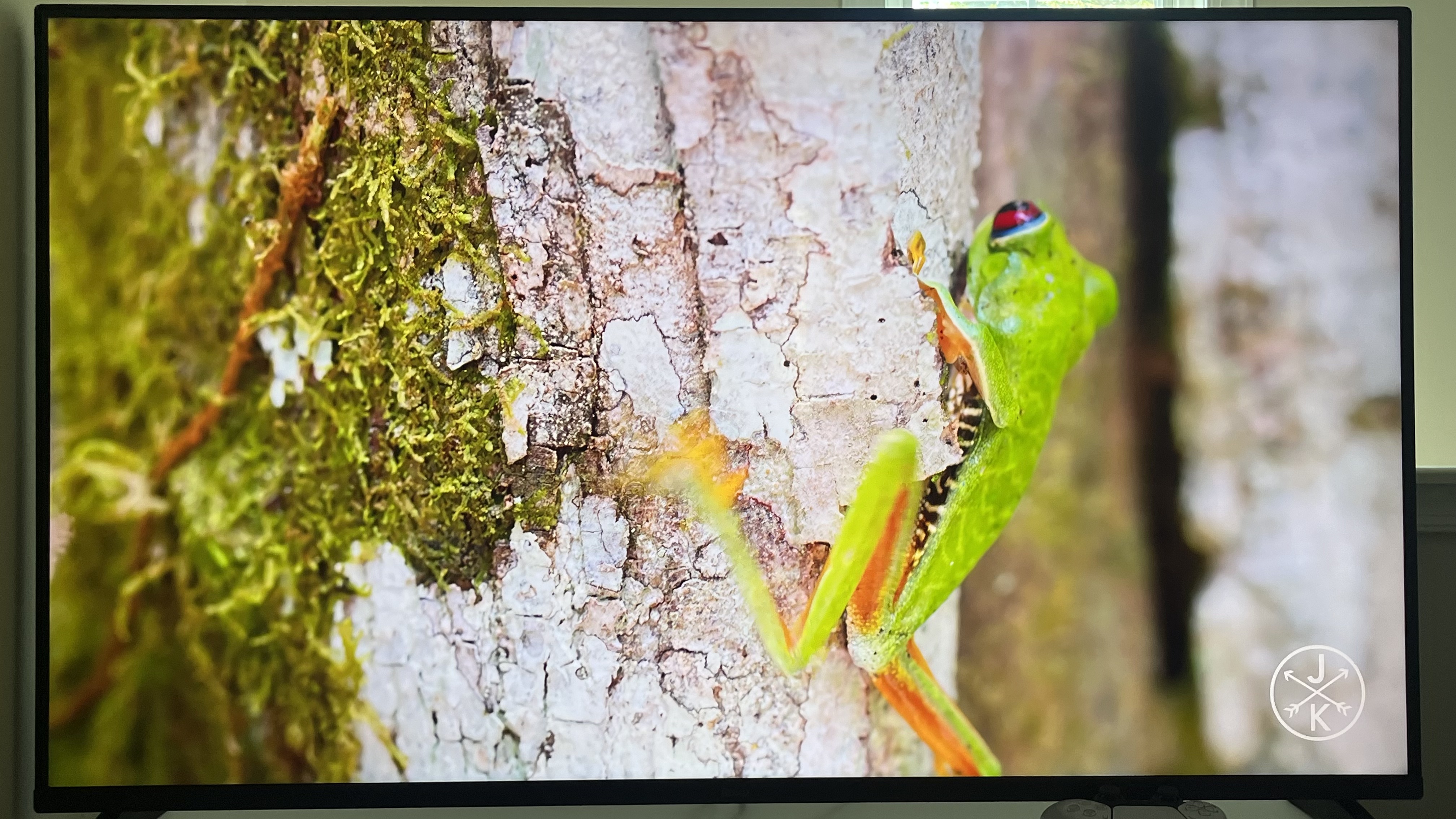
Roku Pro Series review: Picture quality
- Good overall picture quality
- Average peak brightness
- Effective local dimming
You’ll see throughout this review that I’ve given the Roku Pro Series pretty high scores above the board. It can’t be perfect, can it? Well, it’s not. And, where it impresses least is in image quality. However, before you write it off, I will say that I found the image quality to be merely very good. That is to say, most people will find it pleasant to watch but will be more enamored by what it can do than by its stunning picture.
Still, the Roku Pro Series supports Dolby Vision IQ and HDR10+ HDR, and its Smart Picture Max automatic picture mode switching will show whatever content you’re watching in the best possible light.
When watching The Batman, a movie with a lot of shadows in it, I didn’t experience very deep blacks. Because it doesn’t deliver the deep contrast of an OLED screen, the picture could look a little flat at times. But at least I didn’t experience any backlight blooming thanks to the TV’s well-implemented local dimming.
The Roku Pro Series TV works fairly well with sports as well – I had to test with some Olympic Trial diving since I forgot to pay attention during the NBA finals. Colors generally looked good, though skin tones came across as a tiny bit muted in the Movie picture mode. More importantly, the action was crisp and accurate without any blurring issues.
Watching Spider-Man: Across The Spider-Verse (again in Movie mode), this colorful animated movie was done justice, as the transitions between colors, particularly in backgrounds, were accurate and didn’t appear washed out. They could just pop a tiny bit more.
I felt similarly when playing games like Ghost of Tsushima in Game mode. This is a game with a fairly conservative use of color, so when you see something covered in red or purple, it jumps out. That was certainly the case with the Roku Pro series, however, it did seem a little more muted than I’d expect from a flagship TV.
Essentially, the Roku’s performance is nothing unusual for a TV at this price. It has an average peak brightness of 900 nits, for instance. And, if you look at the other benchmarks in our graph, you’ll mostly see average results there as well. There are also plenty of settings available for fine-tuning color saturation, color temperature, and even gamma correction in the TV menus.
- Picture quality score: 4/5
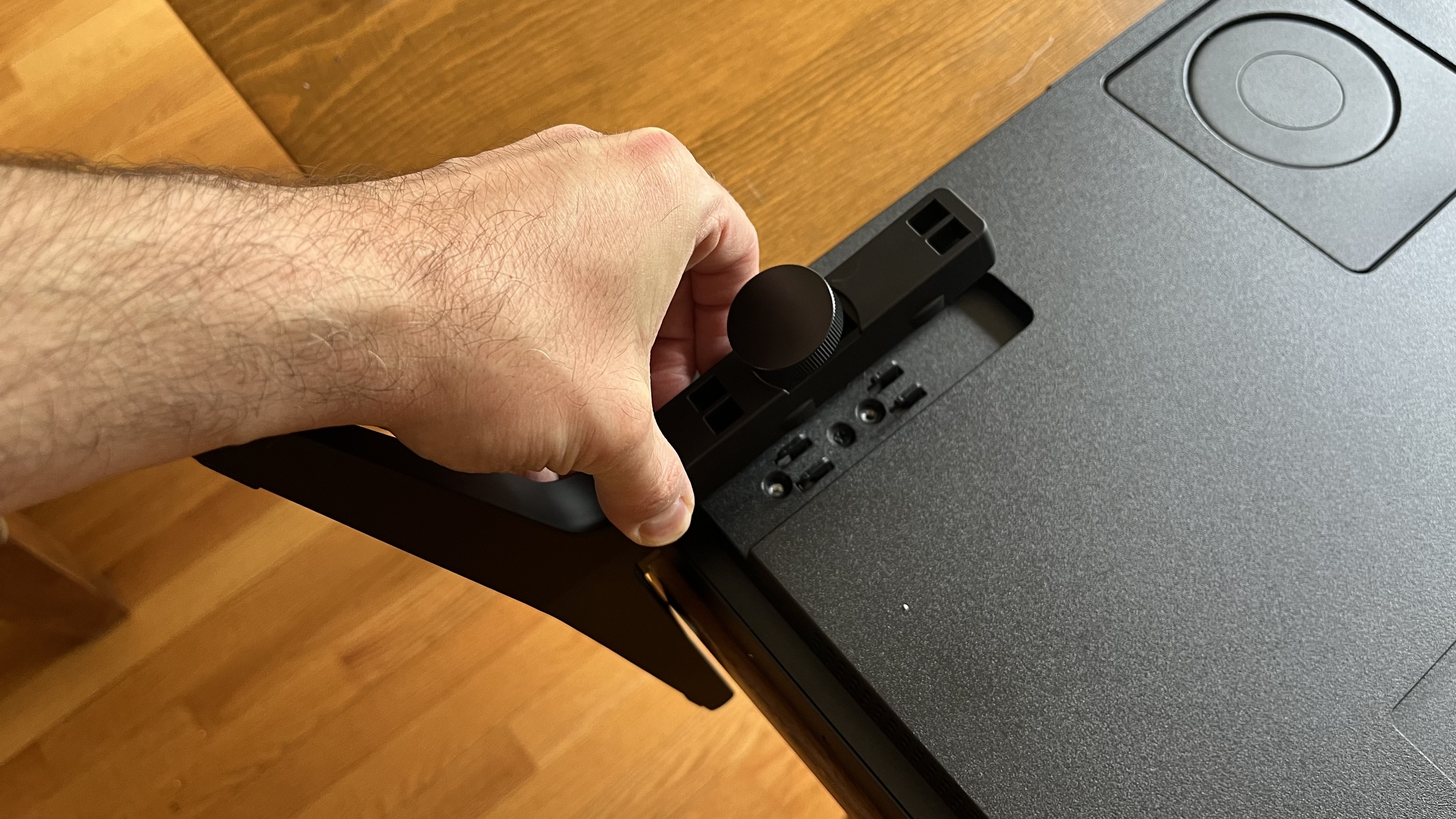
Roku Pro Series review: Sound quality
- Thicker design allows for bigger speakers
- Solid sound if a little light on the low end
- Good enough to skip adding a standalone soundbar
The sound on TVs is typically thin and hollow. While some premium models try to correct this, there’s only so much you can do with thin display panels. Thanks to the thicker shadowbox-style design of the Pro Series TV, Roku was able to sneak in bigger speakers and it shows.
There’s certainly plenty of volume on tap, and the bigger speakers result in a fuller, less boxy sound. Details in the high frequencies retain body as well as clarity. The mids are nice and full. Really, the only thing missing is deep bass, though you could always pair one of Roku’s wireless subwoofers with the TV to fix that.
It should be noted that the speakers are side-firing instead of downward-firing. This means that, instead of the audio waves traveling down and bouncing off whatever surface is beneath them, they travel outward with a direct path to the listener. This helps with clarity but also results in better steering of effects Dolby Atmos soundtracks.
Now, I’m not saying that the TV’s built-in speakers are going to beat or match one of the best soundbars. But, if your soundbar budget taps out at under, say, $300, you’ll be safe to skip it altogether.
- Sound quality score: 4.5/5
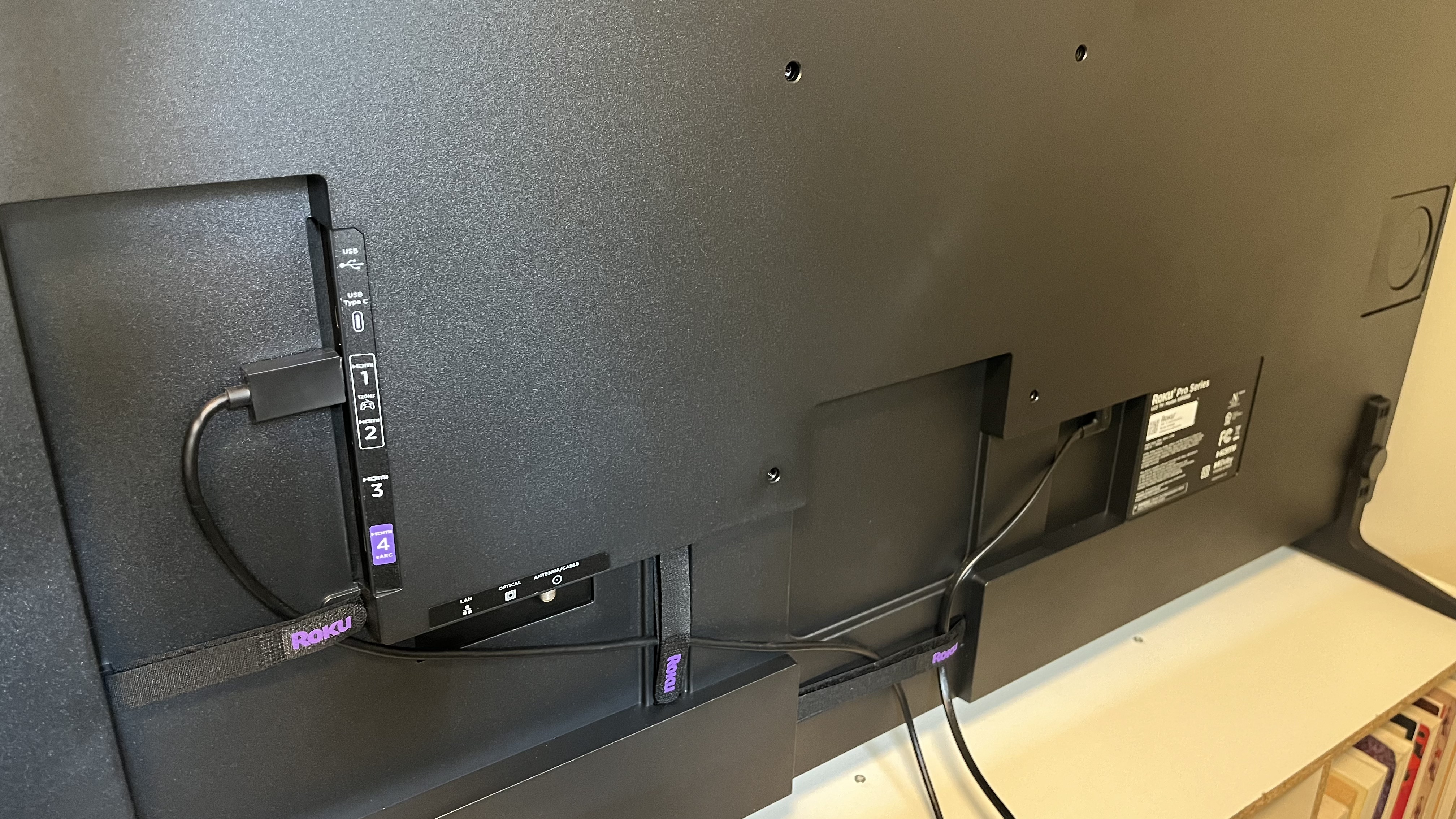
Roku Pro Series review: Design
- Shadowbox design perfect for mounting
- Has cable management
- New, almost flawless remote
The Roku Pro Series might be the thickest TV to come out in a long time, and that’s by design. Using a shadowbox concept, this TV has about a 2-inch depth so that it can sit flush against the wall when mounted.
The back of the TV is molded to accommodate a cable management setup including straps. That’s not only for a tidy look but to keep those cables in place so that nothing gets in the way of the TV sitting flush when mounted. On top of that, the mounting set includes little kickstands that can be used to raise the TV off the wall for easy access to all the ports, which are situated on the back.
Even if you don’t mount the TV, this thicker design allowed Roku to install bigger speakers and better speakers. Also worth mentioning is that the stand installation is completely toolless, and there’s a button on the side of the TV to help find the remote if you misplace it. Press it and the remote will ping.
Speaking of the remote, the new 2nd-generation Roku Voice Remote Pro is a pleasure to use. First off, it has backlighting that turns on as soon as you pick it up, and turns off when you’re not using it. It also has two additional buttons – a guide button for live TV and a quick launch button. I do wish the quick launch (and really the live TV button as well) could be used to directly load an app of my choosing, instead of bringing me to a menu. However, it’s still more convenient than not. Also, the remote has a hands-free mode that can be toggled on so you can talk to it much like you would a voice assistant.
- Design score: 5/5
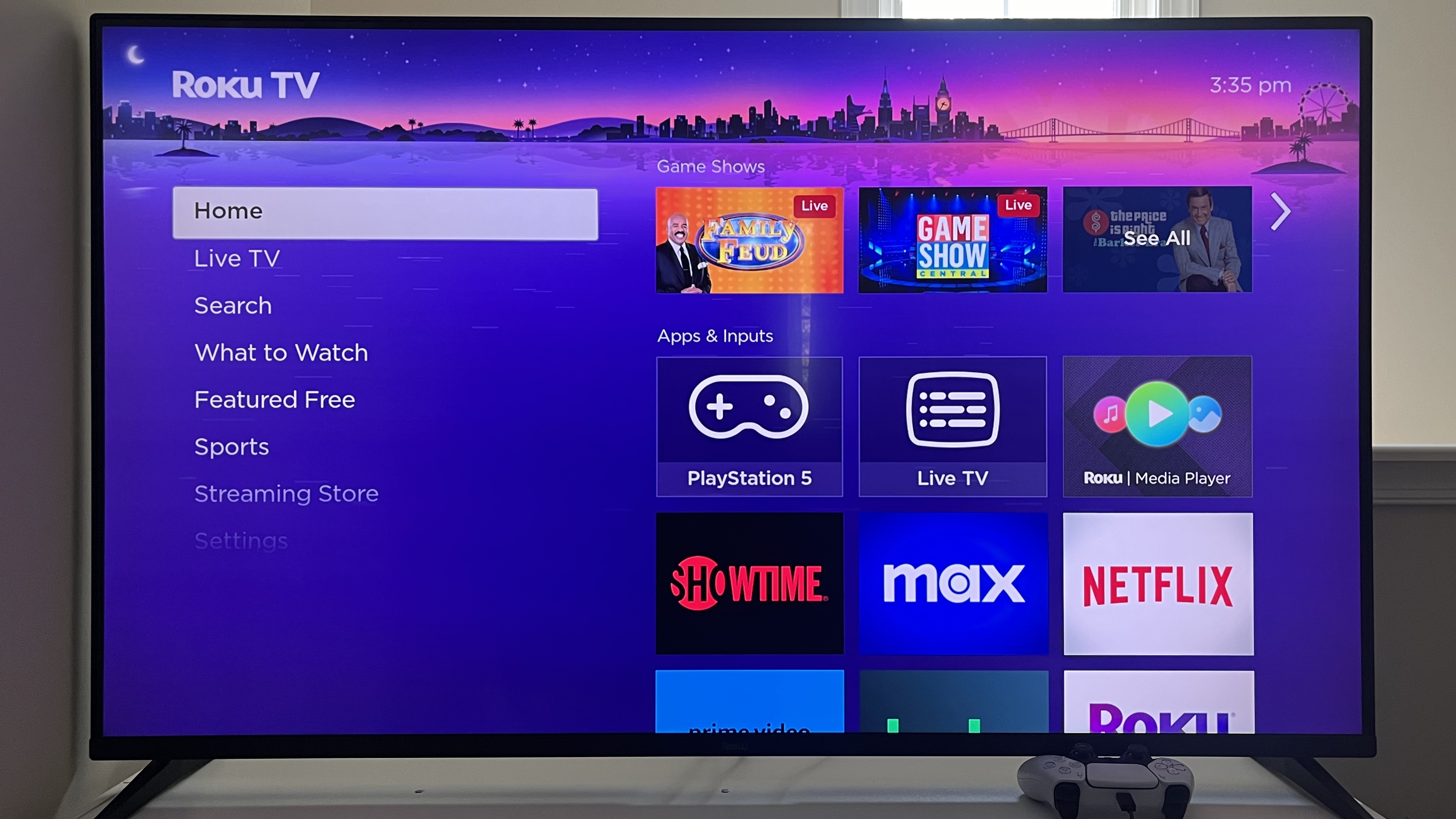
Roku Pro Series review: Smart TV and menus
- Intuitive navigation
- Easy access to picture settings
- Forthcoming Roku Backdrops turns TV into an artwork
The thing that has made Roku products stand out since day one has been the intuitive interface. Outside of accessing a few key features specific to the Pro Series TV, such as fine-tuning the picture or pairing wireless headphones, the interface is the same as it is on any other updated Roku device.
As far as accessing TV-specific settings, I appreciated that quite a few were available without having to exit the media I was watching or playing. Just pressing the star button on the remote let me adjust all sorts of picture quality settings like HDR and Gamma correction along with picture and sound modes, not to mention accessibility settings.
A feature that has yet to see the light of day called Roku Backdrops is sure to excite anyone who ends up accidentally leaving their TV on all the time the way I do. It will essentially make the screen go into art mode, replacing the screensaver with art, and is an especially nice feature if you plan on mounting the TV as a centerpiece in your living room. Roku Backdrops should be available on Roku Pro Series TVs in the second half of 2024.
Lastly, Roku has a lot of free content available, whether through its live TV portal or its own Roku channel. Yes, it may not be Netflix-level content, but some of it’s pretty good, especially if you’re a Weird Al fan.
- Smart TV & menus score: 5/5
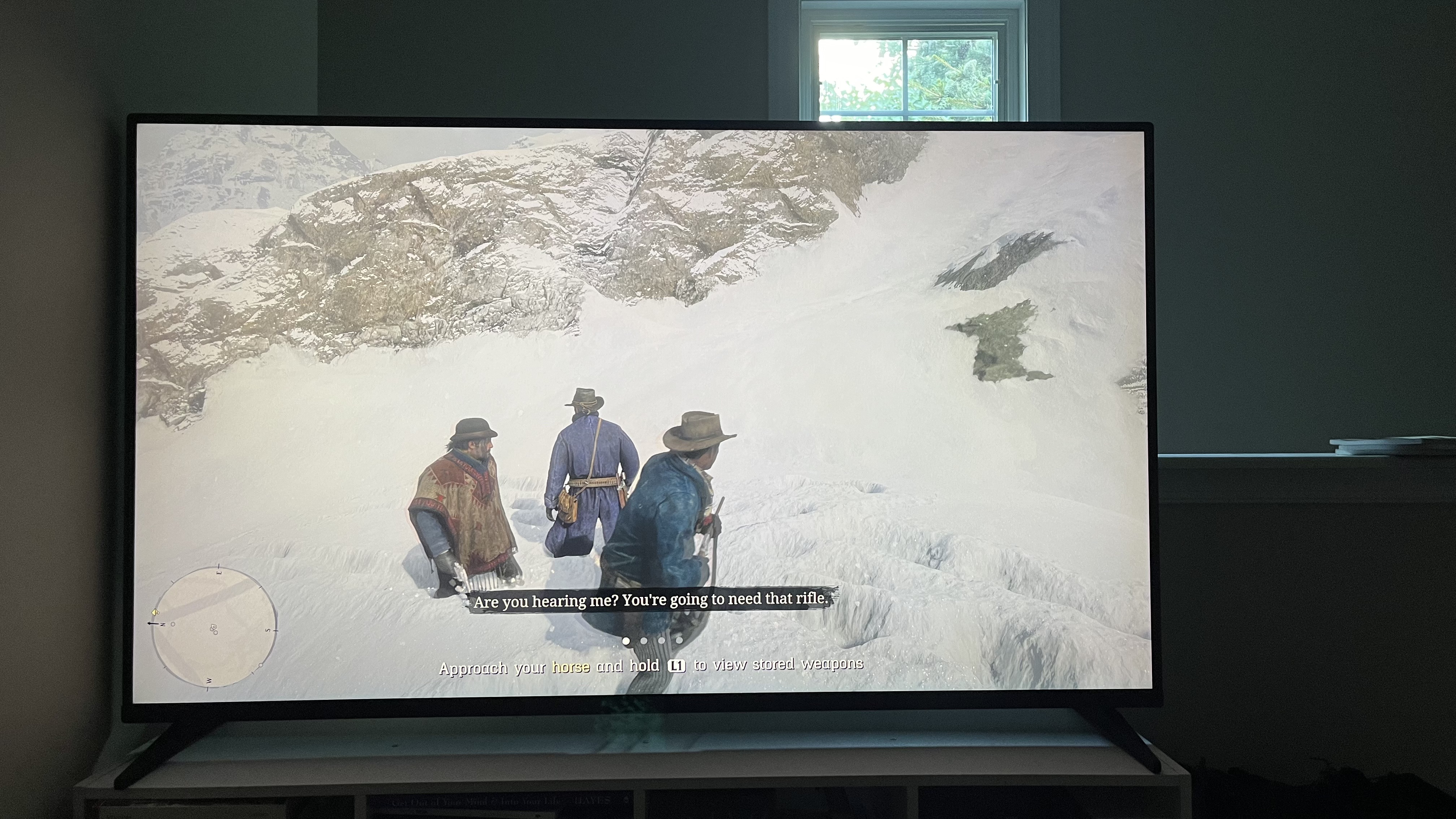
Roku Pro Series review: Gaming
- 4K 120Hz support
- Automatic switching to console input and gaming picture mode
- Good sound for gaming
Since the Roku Pro Series is the company’s premium offering, it makes sense that the company didn’t forget gamers when designing this TV. Unlike many cheaper TVs, Roku’s Select and Plus Series models included, it supports 4K at 120Hz for gaming with PlayStation 5 and Xbox Series X consoles.
Along with that fast 120Hz refresh rate, VRR and ALLM (including FreeSync) are supported, and input lag clocks in at an ultra-low 9.4ms. If you’re a console gamer, you won’t feel left behind with the Roku Pro Series.
The TV’s local dimming helps deliver a consistent picture no matter how dark the game and its HDR support adds to the contrast and depth. Whether I was playing Red Dead Redemption 2, Ghost of Tsushima, or Uncharted 4, I never had issues making out enemies or details situated in darker parts of the screen.
Since the Roku Pro Series automatically switches picture modes, turning on the PlayStation 5 turns on the Game picture mode.I also appreciated that, when I turned on the console, the TV’s interface automatically switched from the main Roku screen to the PS5’s input – though this feature can also be disabled in the settings.
Since the sound quality on the TV sits above many modern-day TVs with their downward-firing speakers, that benefit extends to the gaming experience. Also, you can wirelessly pair the TV with Bluetooth headphones for late-night gaming sessions.
- Gaming score: 4.5/5
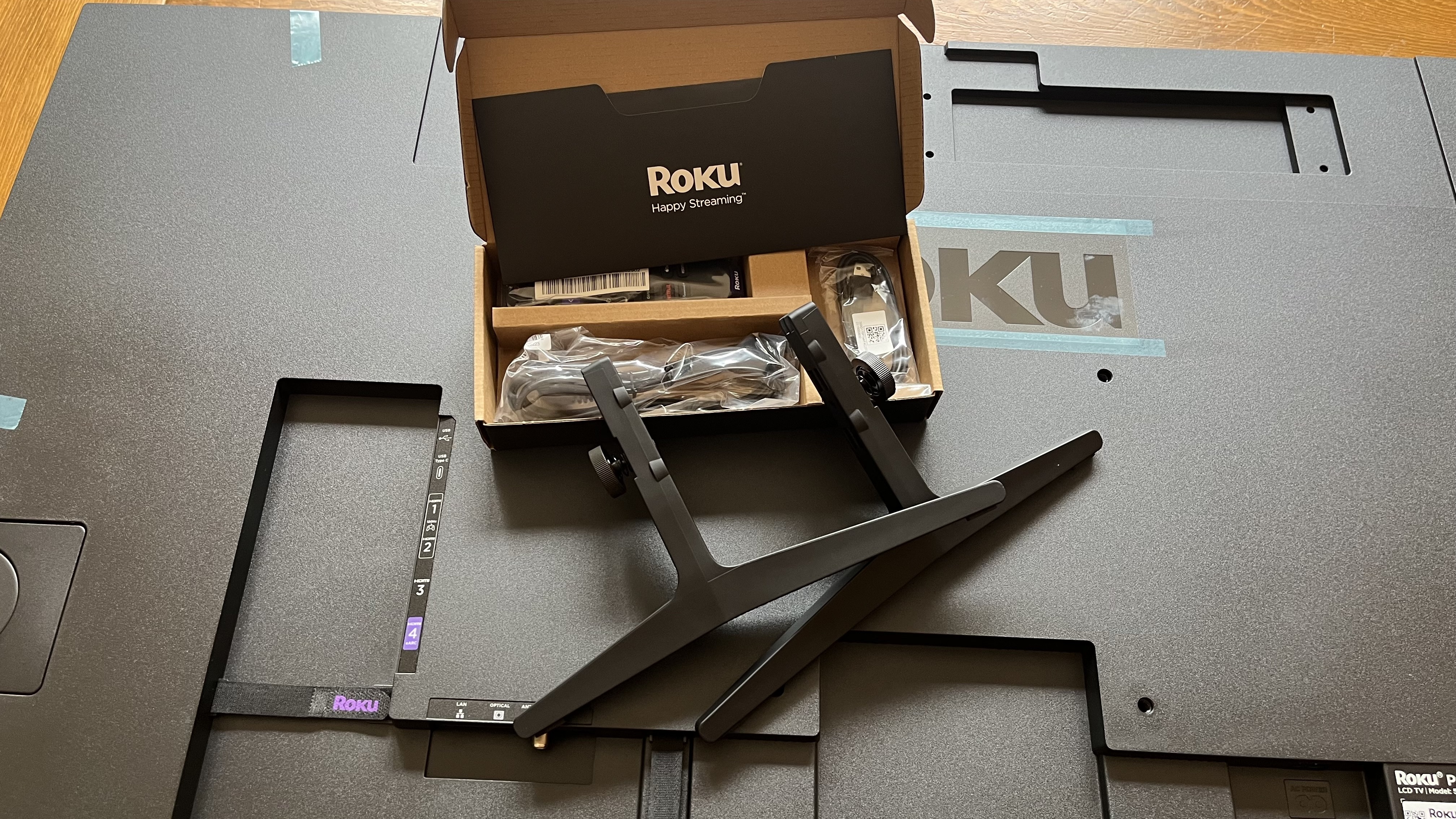
Roku Pro Series review: Value
- Priced closer to mid-range TVs
- Design is unique to the Roku Pro Series
- Significant upgrade over mid-range Roku TV
When you consider other mini-LED TVs such as the Hisense U8K Series, which is currently $699 for the 55-inch model, it helps put the Roku Pro Series TV’s pricing, which starts at $899.99 for the 55-inch model I tested, into perspective. Of course, the Hisense doesn’t have the shadow box design or updated remote, though it does have the hands-free voice command as well as smart home integration.
One of the best TVs for most people right now is the Samsung S90C. It comes with a QD-OLED screen with a beautiful picture that offers deep blacks and detailed shadows. But that model costs $1,599 for a 55-inch screen size. The Roku Pro Series might not reach the same picture quality heights as the Samsung, but it does come with things the Samsung doesn’t, such as Dolby Vision IQ, or that much more intuitive Roku interface versus Samsung’s Tizen.
It’s also worth comparing the Roku Pro Series TV to the company’s mid-range offering, the Roku Plus Series. That series also comes in the same range of sizes, but at a much lower price tag, with the 55-inch going for $499, the 65-inch going for $649, and the 75-inch going for $999. While the Plus Series has Dolby Vision, HDR10+, and HLG, as well as Dolby Atmos support, not to mention local dimming, it has a less bright standard LED backlight and is capped at a 60Hz refresh rate. Additionally, it doesn’t have the same shadowbox design and front-firing speakers, and also lacks the new remote and useful automatic picture mode switching.
- Value score: 5/5
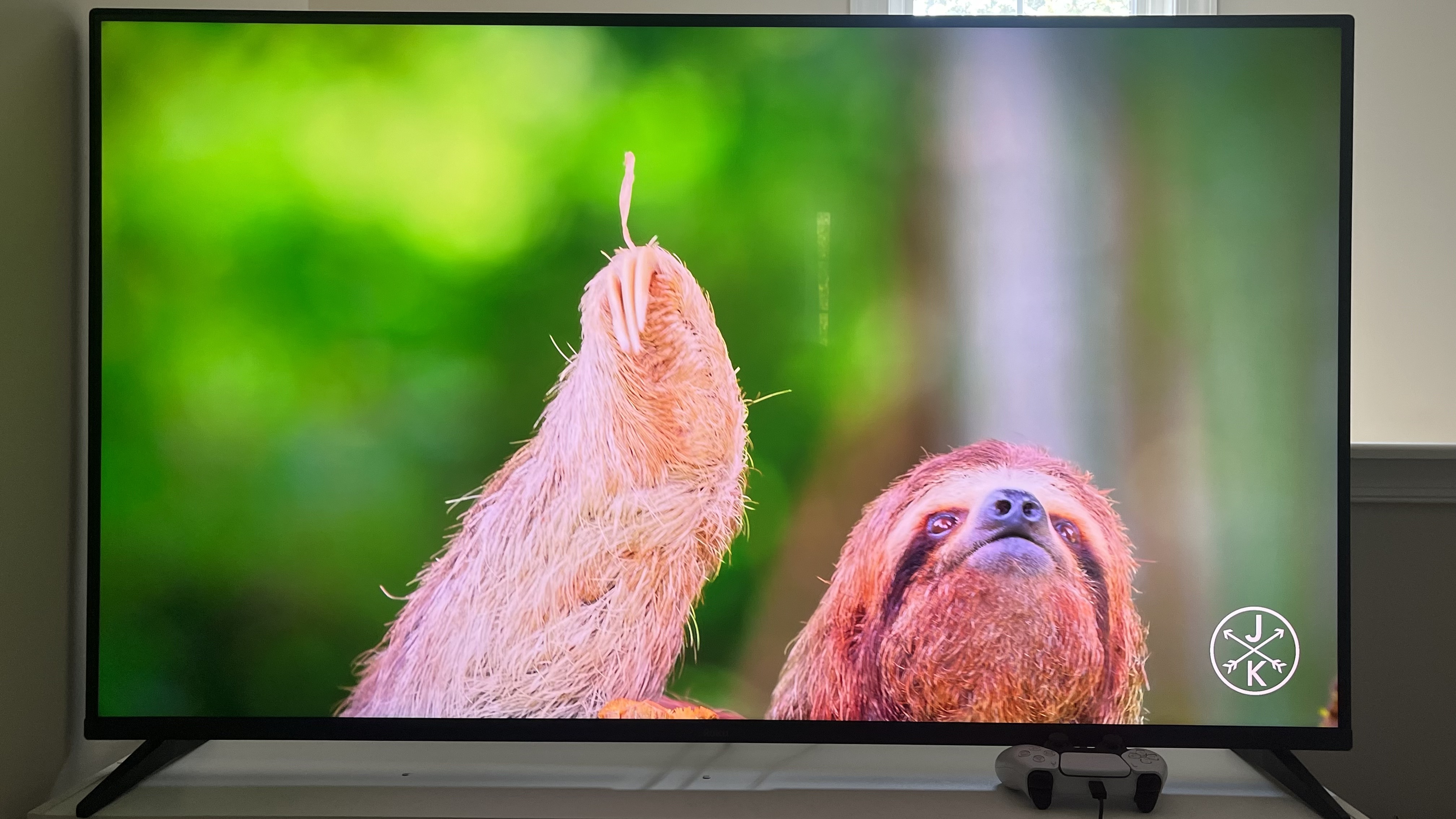
Should I buy the Roku Pro Series TV?
Attributes | Notes | Rating |
|---|---|---|
Features | Smart home compatibility, Dolby Vision IQ, and more | 4/5 |
Picture quality | Good overall picture quality but with average brightness | 4/5 |
Sound quality | Very good sound with side-firing speakers | 4.5/5 |
Design | Unique shadowbox design updates the way wall-mounted TVs look and function | 5/5 |
Smart TV and menus | Roku’s interface is as convenient as ever, and TV-related settings are nicely integrated | 5/5 |
Gaming | Two HDMI 2.1 ports with 4K 120Hz support plus VRR and ALLM | 4.5/5 |
Value | Priced aggressively while providing a significant upgrade over Roku’s mid-range Plus Series TVs. | 4.5/5 |
Buy it if...
You want premium without the price tag
Priced more like a mid-range TV, the Roku Pro Series is very good value considering it’s the company’s premium offering.
You want your wall-mounted TV to look good
The shadow box design is a fantastic design choice, as it makes the TV look more like a framed painting than a thin panel hanging on the wall.
Don't buy it if…
You want the best possible picture
The picture quality is very good here, but there are plenty of premium-tier TVs that are better, with a higher peak brightness and deeper contrast.
You prefer a different smart platform
The intuitive Roku interface is the heart and soul of this TV. It’s more basic than other smart TV platforms, so it may not be for everyone.
Also consider...
| Header Cell - Column 0 | Roku Pro Series | Roku Plus Series | Samsung S90C | TCL QM851G |
|---|---|---|---|---|
Price (65-inch) | $1,199 | $649 | $2,099 | $1,999 |
Screen type | QLED with mini-LED | QLED | QD-OLED | QLED with mini-LED |
Refresh rate | 120Hz | 60Hz | Up to 4K 240Hz | Up to 144Hz |
HDR support | Dolby Vision IQ/HDR10+/HDR10 | Dolby Vision/HDR10+/HDR10 | HDR10+/HDR10 | Dolby Vision IQ/HDR10+/HDR10 |
Smart TV | Roku | Roku | Tizen | Google TV |
HDMI ports | 4 (2x HDMI 2.1) | 4 (2x HDMI 2.1) | 4 x HDMI 2.1 | 4 (2x HDMI 2.1) |
Roku Plus Series
If you want to go cheaper and are okay with a 60Hz refresh rate, the Roku Plus Series TVs are an excellent value as they’re still QLED models with full-array local dimming. You get the convenience of the Roku interface as well, though you won’t have the automatic picture switching, shadowbox design, or updated remote of the Pro Series. Here's our full Roku Plus Series review.
Samsung S90C
If you’re looking to splurge a little more, the Samsung S90C is an excellent option. While it comes with the more cumbersome Tizen interface, the bright contrast-rich, bright picture is worth it, as are the fantastic gaming features. There is no Dolby Vision support, however, as we detailed in our Samsung S90C review.
TCL QM851G
TCL's top mini-LED TV for 2024 has significantly higher brightness than the Roku Pro Series, but is more expensive and lacks the Roku's easy, intuitive Roku interface. In our TCL QM851G review, we called it "a fantastic value" for its combination of performance and features for the price.
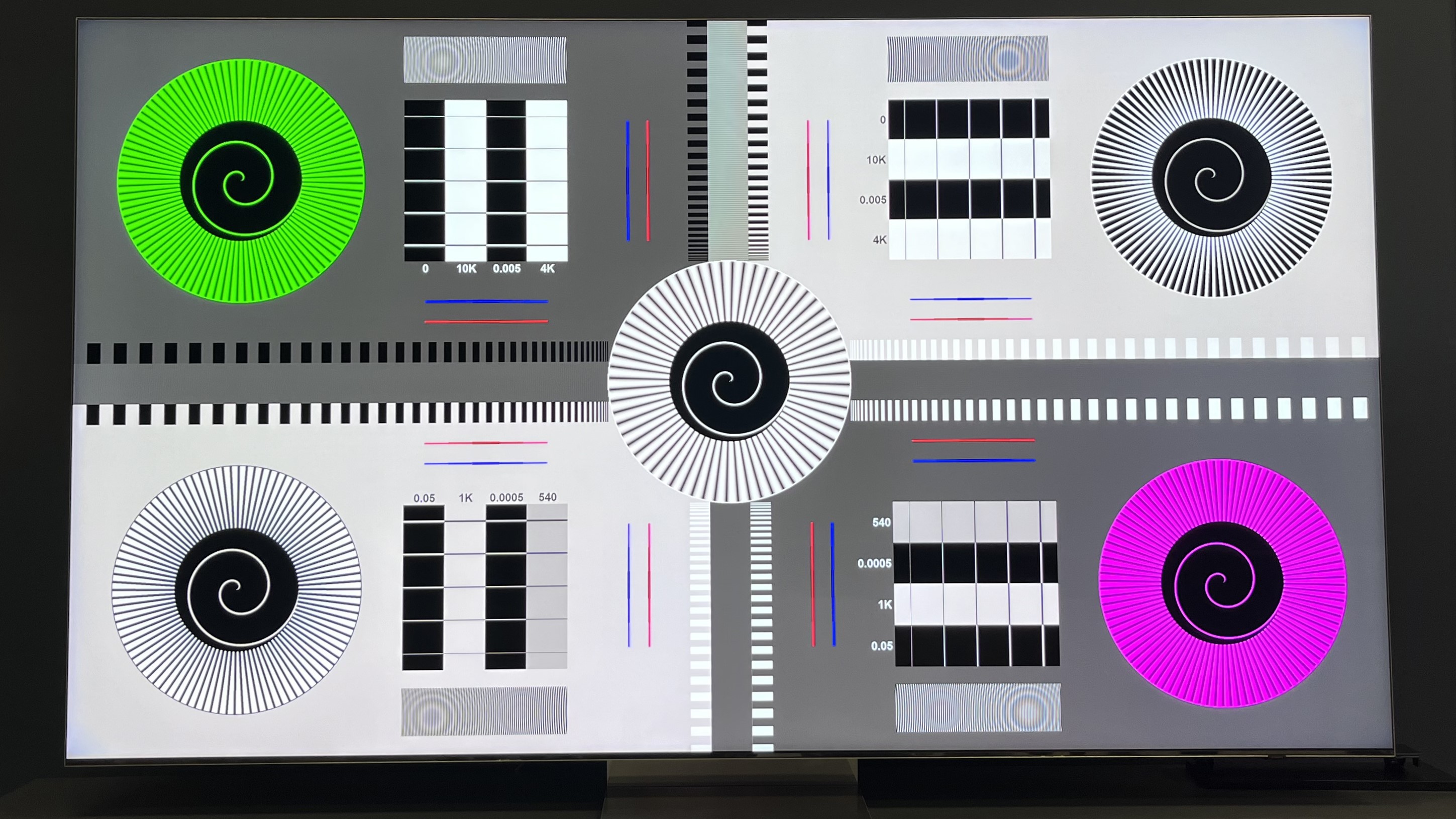
How I tested the Roku Pro Series TV
- Used the Roku Pro Series TV for a couple of weeks
- Tested with TV, movies, music, and games
I used the Roku Pro Series TV regularly for a couple of weeks with TV, movies, music, and games. I tested the various features to see if they work as advertised. I also spent time listening to the audio as well as paying attention to the picture quality.
After spending some time with this TV, it’s my humble opinion that this TV is ideal for two sets of people. The first is people who want a premium TV in a big, but not gigantic size, and therefore don’t want to spend too much. The second are those that hate the way most wall-mounted TVs look.
I’ve tested a lot of tech gear over the years from laptops to keyboards and speakers, and so have been able to use my expertise towards giving an honest and fair opinion, not to mention a critical eye, to any product I test.
You can read an in-depth overview of how we test TVs at TechRadar at that link.
- First reviewed: July 2024
- Read TechRadar's reviews guarantee

James Holland loves checking out gadgets of all sorts, whether it's audio equipment, laptops, or vacuums (especially of the robot variety), and does so for a number of Future Publications including TechRadar, Top Ten Reviews, Homes & Gardens, and T3. He's built up an expertise for in-depth reviewing over the last four years. When he's not putting in the work on the latest tech, he loves to travel, play music, and eat questionable food.
